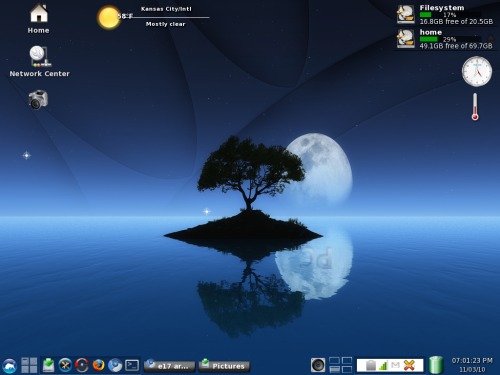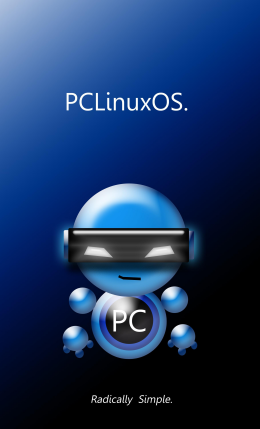E17: An Overview
by Paul Arnote (parnote)
Similar but different would be an excellent way to describe e17, also known as Enlightenment, or simply "E." In many ways, it brings a whole new way of working with and thinking about the Linux desktop. It does so without throwing away everything you've become accustomed to in a Linux desktop, while providing a lot of eye-candy, all within a small memory footprint. As such, e17 runs exceptionally well on older, less capable hardware.
E17 really is a window manager for the X11 window system on Linux. It's not a full-fledged desktop environment, as KDE, Gnome, Xfce and LXDE are.
The cornerstones to the popularity of e17 are its modularity and its ability to be heavily customized to the users needs. If you don't use or need a module, you can simply unload it without sacrificing system stability and features. With the ability to customize the e17 desktop, it means that users can create their own, unique user experience, tailoring the desktop to exactly match the way they work with the computer.

My customized e17 desktop, running the PCLinuxOS-e17 Light ISO on an IBM Thinkpad T23 with a P3 1.13 GHz processor and 512 MB RAM.
History
The first release of Enlightenment was in 1997, by Carsten Haitzler, a.k.a. Rasterman. Under development for more than a decade, the latest stable release is version E16 1.0.4. However, PCLinuxOS uses E17, which just moved from alpha to beta status within the last month or two. The rewrite of Enlightenment for E17 revolved around making Enlightenment more modular, via the EFL (Enlightenment Foundation Libraries). By breaking the window manager into smaller modules, the Enlightenment developers hope to make maintenance easier. It will also mean that only the affected libraries (and the applications that call them) will need to be rebuilt as Enlightenment continues to grow and mature.

Doing More With Less
The efficient use of modules allows E programmers to "do more with less." In essence, the programmers focus on the meat and functionality of a program, and independent "edje" files are responsible for handling the finer points of the graphical user interface. Thus, they don't have to spend large quantities of time on designing and redesigning the user interface (UI) for each and every application that is written.
Memory & System Requirements
The Enlightenment web site lists the minimum memory requirements for running Linux + Enlightenment as 16 MB (and possibly as low as 8 MB). In order to experience the full "Enlightenment experience," 64 MB (and greater) are recommended. For PCLinuxOS-e17, 512 MB RAM is recommended, although it will run and install with less than one-half that amount of system memory.
While Linux desktop systems represent the most common tool used to develop the Enlightenment and EFL (due to the speed), development is done with the goal that it also runs on mobile phones, televisions, netbooks and more. In fact, there are several major electronics manufacturers who have partnered with the Enlightenment development team, including Samsung.
As a result, Enlightenment and EFL have been successfully run and tested on x86-32, x86-64, Atom, PowerPC, ARM, MIPS, Sparc, and other architectures. In fact, as little as a 200 MHz ARM core will provide sufficient processing power to adequately run Enlightenment and EFL.
The graphic needs of Enlightenment are quite modest, as well. It is designed to run on screens as small as QVGA (320 x 240), but the graphics architecture is designed to scale to full-HD (1920 x 1080) and beyond, using displays ranging from 8-bit paletted colors all the way up to full 24/32 bit true color displays.
Impressions
The "full" Enlightenment ISO, containing a wide range of KDE applications, is intended for computers with more modern processors (although, it will typically run quite well on older computers). The "light" Enlightenment ISO is intended for older, slower computers, and uses lighter weight Gtk+ applications. On my IBM Thinkpad T23 (P3, 1.13 GHz, 512 MB RAM, 8 MB S3 Video), the light version runs faster and is more responsive. But it's worth mentioning that the full version also runs quite well. With the full version, I experienced brisk performance until Qt4/KDE libraries had to be loaded in to launch a KDE application. Then, there was about a 10 second delay before the display of the KDE application on this older computer. I experienced no such delays when launching the Gtk+ applications in the light version.
The light version comes heavily customized in the default installation. While experienced e17 users will love its flash and glitz, new users may have some difficulty in figuring out what to do and where to go, since nothing is where you are accustomed to looking for it on the other desktops in the other versions of PCLinuxOS. Fortunately, Texstar has created a package that will make the light version look and act more like the other desktop environments. New e17 users may find installing the package (called econfig-light) from Synaptic helpful in getting their bearings. After all, there are plenty of other things to learn about and explore in e17, and that learning curve is made a lot easier if users have a familiar looking interface to operate in. Users can revert back to the flashy, glitzy screen layout at any time, simply by installing the econfig-itask package from Synaptic.
Conclusions
If you are looking for a Linux desktop that is fast and responsive, that uses a minimum of memory, and that has ample amounts of eye candy, then e17 definitely is for you. Overall, I've found e17 to be very stable. Its ability to be customized allows users to tweak and tune just about every aspect of the interface, and to create an e17 user experience that is uniquely their own.
